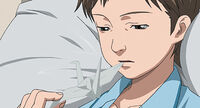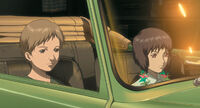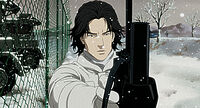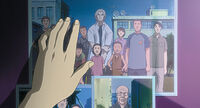| “ | Just as water runs downhill, the human heart also tends to revert to its basest instincts. | ” |
—Hideo Kuze | ||
Hideo Kuze (クゼ・ヒデオ Kuze Hideo) is a Japanese cyborg and ex-soldier who leads the Dejima Refugee group against Japan and the Kayabuki administration. Kuze is featured as a main character in Masamune Shirow's Ghost in the Shell anime series Stand Alone Complex 2nd GIG, notably as the second main antagonist throughout the Individual Eleven Arc. Later in the last episodes, he becomes the deuteragonist following a pivotal turn. A full-body cyborg, Kuze is a cyber-network architect and formerly a JGSDF commando under the mechanized team. After witnessing injustice against refugee minorities and cyborgs, he began to oppose his country's government, making him a prime suspect in Section 9's investigation of the Individual Eleven virus. Beyond the anime, Kuze appears in the 2017 live-action film Ghost in the Shell, where he is portrayed by actor Michael Pitt.
Debut[]
First appearing in the second season as an anonymous assassin, the man who would be known as "Kuze" quickly becomes the target of Motoko Kusanagi's personal interests, sharing a curious connection with her. Among cyborgs, Kuze is quite unique since his body, the Peacekeeping-Force Type, is built for combat. Furthermore, he has chosen to have a sculpted face, which is far more difficult to manipulate than a standard prosthetic design. Due to this, his mouth typically remains motionless while he speaks. [1]
In comparison to the other Ghost in the Shell works, Hideo Kuze is Project 2501's counterpart for the Stand Alone Complex universe
Background[]
Hideo Kuze is the pseudonym of a mysterious cyborg, with little to no classified information on his identity. He starts as one of the known 12 members of the terrorist group "Individual Eleven". Yet during a mass suicide by the Individual Eleven members, Kuze alone survived, leaving and hiding out in the Refugee Residential District.
Encouraged by the refugees' determination, Kuze spearheads their revolutionary independence movement in Japan, becoming a legendary hero and terrorist at the same time.
Later on, it is discovered that when he was six years old, Kuze was one of two survivors from a plane crash that happened in the 2000's. Because trans-humanism was the only way to save him, he underwent a long procedure to become a cyborg. During this time, he established a friendship with a girl who happened to be the other survivor. This eventually grew into a mutual object of affection, yet before the two could bring it further, they both forced themselves in their own separate ways.
This sudden loss pushes Kuze to find his disappeared friend, eventually leading him to his decisive ultimatum against the Japanese Government and Public Security Major Motoko Kusanagi.
History[]
Childhood[]
During his childhood years, when he was still human, Hideo Kuze was a simple boy who still went by 'Hisaragi', after his parents surname. He was unfortunately involved in a plane crash at the age of six,[2] losing his parents in this accident. He was one of two survivors found, the other being a little girl who was completely paralyzed. Hisaragi was also paralyzed, yet partially. His distant relatives came to visit him at first, but they quickly stopped because they didn't care about him anymore, and he was left alone.
As he laid in the hospital bed, the boy looked aside and began to sympathize for the girl who laid in a bed next to him. He started building a silent friendship with the girl, seeing her as the only person he could interact with in this world. Hoping she would recover one day, Hisaragi learned how to fold origami cranes with his only functional limb: his left arm. Such as in Japanese Culture, if a thousand cranes are folded, then a wish will come true. Eventually, the girl was suddenly moved out, and Hisaragi was told she had gone far away. From those words, he believed she had died, thus becoming deeply depressed by that outcome.
Following her departure, he spent two more years continuing to fold cranes in nothingness, convinced that his purpose was to give his utmost heart for the girl, who stood by his side when no one else was. A lot of doctors and physicians had tried to convince him to undergo cyberization, but Hisaragi never answered, ever determined to fold cranes.
When efforts to help Hisaragi were to be abandoned, a physician by the name of "Kuze" brought a cyborg girl around the boy's age to visit him while he was still recovering from his injuries. Hisaragi was initially indifferent. However, the cyborg girl came to visit him often, talking to him and telling him stories even if he never spoke a word during their meetings. He was always listening silently as this new friend gradually entered his life. She tried to convince him to become a cyborg, although he never wanted to.
One day, out of nowhere, he spoke for the first time and asked his new partner if it was possible to fold cranes with a cybernetic body. If such deed was possible, then he wouldn't mind becoming prosthetic. The girl tried many times, but kept failing to fold a complete crane.
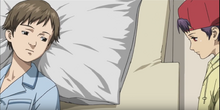
Hisaragi watching the cyborg trying to fold cranes
She couldn't achieve it since she was unable to adeptly manipulate the fine motor skills of her prosthetic parts. Hisaragi was crestfallen by her failures. He then told the cyborg that he would stay human, if it meant he kept his ability to fold cranes. Seeing the boy's disappointment, the cyborg girl left in shame, but not before she promised to return once she was able to fold cranes for him. It instantly prompted Hisaragi to realize she was the same girl he believed had died. He understood she had gone successful treatment and returned to him. He never saw her again, nor did he understand why she never revealed her identity to him. Yet touched by her act, he quickly became determined to find her, and decided to undergo the same full cyberization procedure. The transformation was painful, but when Hisaragi thought about how much his friend had endured, he became a cyborg with ease. At some point later, he was adopted by the physician, whose surname "Kuze" he adopted as his own.[3]
Years later, during a visit to a university, Kuze finally found the girl's empty body in one of the laboratories. He recognized it as his friend's model and decided to bring it to an antique gallery, where he preserved it along with his own childhood shell. He had the help of the shop's owner, whom he got to know well. The antique gallery served to keep memories for cyborgs who wanted to forget them, but Kuze ironically had the motivation to keep a memento of his past. However, before he could resume his search again, he was abruptly enrolled as a soldier for the Japanese Army, thus he never returned to the shop. Further more years from that, while Section 9 was testing out their new recruits, Major Kusanagi stumbled into the antique gallery. Entering the captivating place, The Major indeed found the cybernetic body from her childhood, with her lost friend's model sitting beside hers. The owner saw that Motoko had some sort of connection, and decided to tell her the story of the souls that once rested in these two bodies, oblivious that the Major herself was the girl the boy had been searching for. The owner then revealed to Motoko that years after the girl's body was found, the boy, who was now a man, still tried to locate her, but was ever unsuccessful. He was ordered to be shipped out as a soldier, and was never seen again, possibly because he died in action. The Major, rarely emotional, instantly became saddened at this statement.
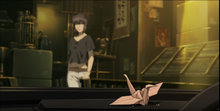
"I'll bet that even now... that girl is still searching for the first boy she ever loved"
Dejected, but impressed by his unflinching determination, she sneakily folds a crane with her left hand, proving that she finally arrived to his request after so many years. Leaving her handiwork just beside Hisaragi's empty body, Motoko prepares to leave, but before doing so, she admits that he was the first person she ever loved, oblivious that he was still very well alive.[4]
The Peninsular War[]
When he was deployed to Korea, before joining the Individual Eleven, Kuze was a soldier for the Japanese Self Defense Force (JSDF). In 2024 after World War IV, The American Empire deployed United Nation (UN) troops to where internal conflict continued in North Korea. Japan was offered excavation rights if they deployed their JSDF troops, so they did it with no hesitation. Kuze, in a mechanized infantry unit,[5] was stationed with the PKF-issue hybrid cyborgs, they were ordered to circle north of Shinuiju and launch a preemptive strike on the People's Army. During the ascent of the mountain, Kuze himself had found a refugee camp along a river crossing the border. This area was not mentioned to the platoon in the intelligence report issued by the JSDF.
At the time, the camp was being looted and pillaged by the soldiers of The People's Army, whose intentions were to become bandits. Seeing this, Kuze was driven by morale and heroism, ordering his platoon to engage in combat. One by one, soldiers of the People's Army began surrendering. Kuze's men saved the remaining villagers in a very lopsided battle between crack cyborg commandos and starving People's Army soldiers, which will result as the only real combat they ever saw.
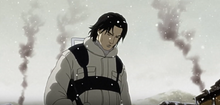
Kuze after battle
After fighting the People's Army, the platoon were advised to be aware of possible guerrilla attacks on the camp. A problem later arose in the platoon camp, when the soldiers began suffering from post-traumatic stress disorder due to the experience of gunning down people in their first battle. Most of the soldiers who retained most of their original body organs began drinking alcohol and using drugs smuggled in by the refugees to escape the nightmares of the massacre.
When order began breaking down in the JSDF, the Japanese media began pelting insensitive comments at the platoon. The criticism of the platoon's behavior was more severe due to censorship of the massacre which hadn't reached the media. The soldiers' freedom was later restricted due to policies designed to prevent further disgrace. Many of the soldiers were barred from returning to Japan. Some footage of the refugee camp massacre was leaked to certain broadcast stations, but created false information.
A misleading rumor began to spread that the JSDF executed the massacre. Riots broke out demanding an explanation to the massacre, while soldiers couldn't defend themselves from an outbreak of gossip and unproven statements. On a fateful snowy day, while a journalist was commenting pejorative remarks on one of the soldiers, Kuze happened to be nearby. The commando silently approached the journalist and agreed specifically with the man's rants about foreign invasion. Kuze reveals he's tired that the Government deployed the army for the image, not caring for their soldiers nor the collateral damage. In short words, they were not taking responsibility for their actions. After stating his viewpoint, the cyborg then demanded to trade his assault rifle for the journalist's camera, taking the latter by surprise. When the journalist accepted the offer, Kuze simply walked into the refugee camp and was not seen by any of his platoon scouts again.
Refugee camps[]
Kuze wandered in the snow, staying in the nearest camp he came across. He began traveling around the land, observing the life of refugees by taking pictures. While travelling through the camps, the elderly became interested in Kuze and offered him drinks, children asked him to fold paper planes and origami figures. Young men and women stood in lines telling him of their life stories, while he never spoke a word. He often smiled at them and took their photographs. Quickly rising in popularity and respect because of his easygoing personality, Kuze inspired hope for the refugees as he slowly became a symbol of rallying.
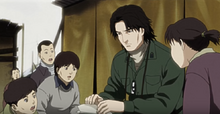
Kuze folds origami for the children
Three months later, the People's Army surrendered, the JSDF was cleared of its obligations, and the media stopped talking about the massacre. A day before the JSDF was to withdraw, Kuze disappeared from the camp, leaving behind only his dog tags. He was believed to have crossed the border and headed west into Taiwan. Interestingly, he actually did so. Just like the first camp, Kuze again became popular in the new refugee slums, and people nicknamed him "Ro", for wolf. He was a prolific idol, and was well known by the local residents thanks to his honest concerns for those in need. Criminals and opportunists often feared him, staying in the shadows when he was around. Later on, while investigating the "Individual Eleven" case and Kuze's potential culpability, Ishikawa, Section 9's info specialist, mentions he met a man who has seen Kuze in the Taiwanese refugee camps. Apparently, the informant said that Kuze was always someone who could gather a friendly crowd around him. The man Ishikawa met also noted that Kuze's hair had gone white in time, implicating that he never changed his prosthetic body.[6][7]
The Leigo Island Incident[]
At some point before the Individual Eleven Events but after the closure of The Laughing Man incident as shown at the end of the SAC storyline, Kuze arrived at the Leigo Island, a privately-owned resort island electronically sequestered from the outside world. The island had the capability of providing synchronized fake sensations to any of its presumably rich vacationers by intervening into the cyberized senses of touch, taste and smell.
Kuze, who was going by the name of Hisaragi and called "Hide", was there to follow a possible lead on the terrorist Jupiter. He was currently serving as a freelance prosthetics consultant who was active in tracking down terrorists. During that time, he forged a particular friendship with Aoi, The Laughing Man. He is the one who gave Kuze the prefix pseudonym Hideo. [8]
The Individual Eleven Events: Birth of a "Hero"[]

Kuze the Delivery Man
After leaving the Leigo Island, Kuze was still motivated to help out the refugees. He joined the terrorist-nationalist group known as the Individual Eleven in order to find the reasons behind their attacking the refugee community. However, during his search, Kuze got infected by a virus by the same name, conspired by a mysterious creator. Under the apparent possession of the virus, Kuze decided to assassinate Prime Minister Kayabuki in an exhibiting way, incorporating the No theater style and the classicism of Japanese coup-d'états in his motives, sending letters of threats and menaces. He sneaked inside a Buddhist temple where Kayabuki resided, disguising himself as a delivering clerk using a truck and making an origami crane as a token for self-person. Since Kuze sent a lot of threats before then, Section 9 and Motoko Kusanagi were already stationed at the temple for the Prime Minister's protection. During the night of the attempt, Kuze used his invisible camo and a katana to attack the Prime Minister, shouting "righteousness is by my side" once he revealed himself. Before the blow had landed, Kuze was interrupted by Motoko, who fired at him relentlessly. Due to his resilience, Motoko changed tactics and engaged him close combat.
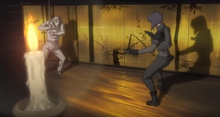
Major faces off the Assassin
During their clash, The Major warned Kuze that he was outnumbered. Batou emerged from his cover, assisting Motoko by shooting at Kuze. Once again, Kuze was not injured. He then swiftly escaped by bashing through the rooftop. Motoko concludes the assassin didn't want to kill PM Kayabuki, but still has ulterior motives. Motoko based this possibility while noting how much of a great foe Kuze is: Prepared, ready, equipped and most of all, lethal. There was no reason for him to back off, aside from letting the Prime Minister live.[9]
Kuze remained under the radar for a while. Motoko continued to investigate the mysterious Individual Eleven philosophy , and its links with Kazundo Gouda of the Cabinet Intelligence Service. By accessing surveillance camera footage, Motoko retraced the nameless man with white hair, recognizing him as the assassin. In reality, the man, who was in fact Kuze, had gathered with his comrades to unleash a mass suicide that symbolized the love for their country. Kuze arrived at the group's rendezvous point, where he was the last man expected. His alibi for joining the group was his attempt against Kaybuki's life; the other members admired his bravery. In contrast to their preferred black, Kuze donned white clothes, foreshadowing his future actions.
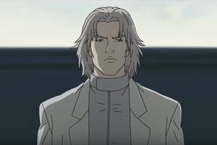
The last man standing
During the road to Kyushu Radio Tower, where the group would take action, Kuze starts to have doubts, so he asks for a copy of the ideology book: Individual Eleven. When his co-members tell him they all forgot their own essay, Kuze realizes he's being played, and that the Individual Eleven is just a false idea created by someone in order to spur chaos to the refugee communities. This is a moment where his stiff mouth only moves slightly. After remembering the reason why he joined the Individual Eleven, Kuze manages to break off from the virus and secretly resumes his goal to fight for the refugees. The Individual Eleven members gather up at the radio station, where a speech about the false essay is held. Kuze simply gazes upon the rainy horizon and considers his escape route. When the suicide ritual starts, Kuze tries to help his assailant, but fails and is forced to kill him. Finally, Kuze jumps from the building and heads back to Dejima, the Refugee District. Now completely free from the cyberbrain virus, Kuze roams Japan as a wanted man, oblivious that Gouda, the man behind the Individual Eleven, had planned Kuze's survival.[10]
Motoko later finds information about Hideo's physical prowess, pseudonym and body components. This is all thanks to Ishikawa's research, but none of such information can still disclose Hideo Kuze's real identity. She does take in mind that Kuze possesses a rare physical constitution, composed of regenerative skin and a sculpted face model, which makes it hard for him to move it. All traces of Kuze's whereabouts fall in the unknown, until Ishikawa plunges into a deeper investigation leading to Taiwan. There, Ishikawa manages to dig up the military backstory of Kuze, the Peninsular War events, and Kuze's role in the refugees' insurgency. Motoko begins to take a personal interest to their suspect after she eavesdrops Ishikawa's investigation report. Due to the mention of his folding origami figures, she thinks Kuze's story is quite interesting.
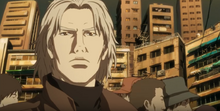
Kuze's emotionless stare to the sky
Meanwhile, Kazundo Gouda and the CIS have located Kuze, who finally reached Dejima. The CIS decide to keep track on him and spy his actions, in order to succeed Gouda's geopolitical plan. In the refugee island, Kuze walks the streets wearing new garments. Crossing the light of the sun shining towards him, he gazes upon the sky just a moment, before resuming his road to his ultimate goal, disappearing yet again.
The Plutonium Deal[]
Now at the beginning of his grand campaign, Hideo Kuze decides to give the refugees some sentiment of power. He uses his connections to strike a deal with the Russian mafia, in hopes to buy a plutonium bomb with which the refugees will use to coerce Japan to recognize their independence. The deal involves a meeting in Etorofu, but during the preparations, Kuze is interrupted again by Motoko Kusanagi who is diving inside his cyberbrain.
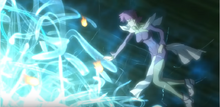
Chroma connects with Kuze
Reaching Kuze's ghost, The Major discovers he is carrying the souls of 3 million people, which grants him great knowledge about the refugee situation. But while running through Kuze's personal information, Motoko is suddenly detected, and despite her Chroma disguise, he sees through the infiltration with ease. Knowing everything about his attacker, Kuze curiously warns Motoko not to interfere with his consciousness, since she will also be assimilated to his mentality. This sympathetic reaction intrigues the Major, prompting her to have contact with Kuze's mind, yet the simple touch of his netrunning signal instantly sends her off his ghost due to the immense strength of his intellect. In a state of shock from what she had just seen, Motoko Kusanagi gains insight of Kuze's true goals, but realizes she knows him.
After the encounter, Motoko manages to take information about Kuze's whereabouts, but the impact left by her connection with him makes her turn for the wrong location. Kuze used this opportunity to set a false direction for Section 9, giving him more time to get the plutonium deal over with. He warns his men to get prepared for a police pursuit, reminding them to avoid any violent and useless conflict. His wishes are in vain, as the refugees engage in a gunfight with Motoko and Section 9, killing Yano during the shootout. The refugees are quickly wiped out by Section 9, but the squad's operation is a failure since they couldn't locate Kuze, and lost a recruit for no good reason.
On the other side, Kuze complains about the refugees' headstrong nature, but manages to win time just like he expected. He reaches Etorofu, where he meets a group of armed rebels near the shipment docks, knowing him only by name. At first sight, the rebels somehow recognize him and are immediately motivated, ready for a revolution.
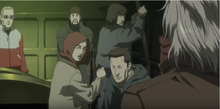
The armed refugees intuitively recognize Kuze
The little group gathers around Hideo, but a young man who wears a red hood recognizes him as the only Individual Eleven member who survived. Kuze explains the procedure for the deal and the rebels prepare for the transaction trade. They also gather weapons for the road to Dejima. The young boy takes an opportunity when there are no witnesses, and confronts Kuze, cornering him in one of the boat's chambers. He tells the white-haired cyborg that he joined the coalition to get weapons to defend himself.
However, the young boy adds that he wouldn't be here if he knew that Kuze, the only Individual Eleven member to survive, was the person who lead the rebellion. Kuze replies that if the boy isn't motivated to be led by him, he's free to leave. The boy counters by saying he won't, due to his motivation for revolution. He says that Densetsu, a rapper and the one who taught him to revolt, was killed by the Individual Eleven. He shuns Kuze for being responsible, but Kuze reminds the boy that Densetsu's murder was a third party attempt. The boy proceeds to show his self-armed bombs, ready to commit suicide and show Densetsu's teachings. Kuze is unmoved by the youngster's attitude. He argues that suicide bombings only serve to soothe bruised egos and self-righteousness. He tells the boy that true revolutions are not led by material desire, but by true beliefs and values. A bearded refugee wearing a beanie suddenly enters the chamber, which sends the young rebel into a panic state. Demonstrating charisma and confidence, Kuze calms the boy and wins his trust by revealing his intention: Make Dejima an independent country by using the plutonium bomb to coerce Japan.
Just a moment later, the other rebels return, and so, Kuze shows the income source of the Refugee Coalition's money. He insists that he uses fair money transactions in order to show the refugees' struggle for freedom and human rights. When questioned about the source again, Hideo says the money comes from his extracting extremely petty sums not transferred or loaded by the bank.
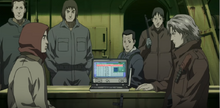
Kuze explains his complex method to gain easy revenue
In that case, Kuze had managed to hack the worldwide system and collect those tiny sums, which are numerous around the world, and took them in his dummy bank account. This makes him earn quick revenue for the bomb. Kuze finally admits he is aware that this system is corrupt, but exploits it with intentions to show the world of the fact that money blurs humanity from their sense of morale. Astonished by his leader's grandeur, the youngster asks what sort of man Kuze really is. Kuze replies that he's just a terrorist, albeit with an inspiration of heroism. With everything settled, Kuze asks the boy to wait and get the ships ready for emergency escape. He and the other rebels head out to buy the plutonium once and for all, but unbeknownst to them, Batou, Saito and the Tachikomas from Section 9 had tracked them down. They follow a path to a tunnel leading to a mining zone.
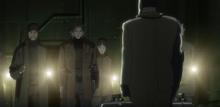
The Russian Cyborg meets with Hideo Kuze
Around the same time, a rebel posse led by Hideo arrives at the mining zone. They bring the money to the Russian cyborg, Koil Krasnov, who is carrying the plutonium suitcases. They seal the contract, but shortly after doing so, the refugees are betrayed by the Russian Cyborg. Out of nowhere, a group of Japanese Army mech suits ambushes the crowd, even taking Hideo by surprise. The Russian cyborg takes cover and leaves Kuze behind as the slaughter continues. Multiple rebels are killed, only a bearded rebel and another with sunglasses survive the massacre.
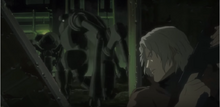
Kuze scouts a path to get the suitcases back.
Kuze fights off the armed suits, but doesn't manage to get rid of them due to the risk of destroying the suitcases. In the nick of time, the Tachikomas arrive to intercept the armed suits, and Batou locates Kuze with infrared scanners. Batou and his Tachikoma are subsequently assaulted by another mech suit before they can arrest the refugees' leader. Seeing an opening, Kuze soars from his cover and grabs the suitcases. Kuze flees with his two remaining henchmen while Batou is forced to fight the mech suits. Saito helps Batou and they decide to split up after clearing the hostile area. Saito rushes for the Russian cyborg while Batou catches up to Kuze on foot. Batou holds Kuze at gunpoint and orders him to drop the cases.
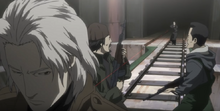
"Kuze, hold it!"
Kuze does so, but is intrigued: Batou didn't shoot him rightaway. The ranger boasts that all he wants is beating the PKF cyborg, and doesn't give a damn for the suitcases. Kuze orders his refugees to retreat with the cases, and insists that Batou can't fight him. Due to Batou's personal vendetta against the PKF cyborg, Batou is angered and challenges Kuze to a fight, secretly wanting to see the reason why Motoko is suddenly so affected by him.
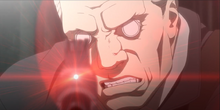
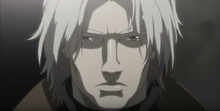
Ranger vs PKF Commando
Batou taunts Kuze by commenting on Kuze's confidence with his PKF body. Kuze retorts his body is actually out of maintenance, so it does not really give him any advantage whatsoever. Batou gets annoyed at Kuze and opens fire. Kuze blocks the bullets with his palm, tumbles in front of Batou, and pulls out a bayonet knife. Kuze strikes the blade to Batou's gun's barrel, then kicks off the gun from Batou's hand. Kuze backs off and adopts another fighting stance, while Batou pulls out his signature combat knife. Following a tense moment of silence, they reengage in hand to hand, where Kuze disarms Batou once again with a triple rotating kick. Kuze takes a chance to lunge his knife, but Batou elbows Kuze in the face. When Kuze drops his knife, Batou gets the upper hand and throws a flurry of punches straight in the terrorist's face, confident that the latter's brain will have his anti-pain receptors turned off. However, Batou underestimates Kuze and is taken by surprise when Kuze grabs his leg in the middle of a leg swing, twisting and dislocating it in a swift move. Batou falls and Hideo pins him with a metal pipe, putting Batou's left arm out of commission. Impressed by the ranger's skills, Kuze congratulates him, but tells the Public Security operative not to follow him again. Kuze takes the ranger's large knife and runs off. Kuze rejoins the rebels, but learns that the young boy mysteriously disappeared. With no time to waste, he orders his men to sail off, but Motoko Kusanagi arrives with a handful of Tachikoma units, attempting to intercept the rebels' escape. More rebels are killed, but Kuze's boat leaves the docks.
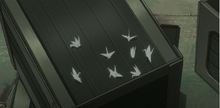
Motoko desperately tries to stop him, but isn't able to do so. Before the boat reaches the sea, Kuze and the Major exchange solid glares. After the refugees escape the port, she finds a set of folded paper cranes on a crate. Her suspicions growing, she keeps a crane for herself, unbeknownst to the rest of her team. Batou however, notices the Major's strange behavior, and expresses his irritation about her peculiar feelings for the rogue cyborg. Motoko finally admits to Batou she's almost sure that Kuze is her long-lost childhood friend and first love. Batou learns about Kuze's devotion and role in saving Motoko's life.
Kuze's Revolution[]
Once the boat is clear of pursuit, Kuze takes a chance to verify his package. However, he discovers the Russian Mafia, who are secretly Gouda's CIS, had tricked him by selling lead bars. Kuze remains calm and holds this information to himself, since he still possesses a geopolitical influence.

Kuze's officers and friends
Heading to the ship deck, Kuze is accompanied by two survivors, who are also his best men: the refugee with a beanie and the other with sunglasses. When they see their boss, he informs them to take separate routes in order to leave foil traces. At first, they are hesitant to leave Kuze, but after a moment of consideration, they trust his judgment and follow his orders.
A security patrol boat later finds Hideo Kuze, with Section 9 taking hold of the situation. However, the patrol crew falls into panic once Kuze retaliates with a heavy turret machine gun. This gives enough time for the cyborg to flee. To further ensure this escape, Nagasaki's electricity is suddenly shut down, which prompts the patrol crew to look away and lose sight of the fugitive.
Meanwhile, Section 9 admits they're in a terrible situation. Gouda's pseudo-war plan appears to succeed, since Kuze is believed to possesses a nuke and seems to play every step of the Cabinet Intelligence Service's plot. However, amidst Section 9, Motoko feels something greater than both Gouda and the refugees, which involves the unspoken intentions of Kuze himself.
Escaping the radar of the Public Security for now, Kuze sets foot again in Dejima, where his men are expecting him. They prepare for the fight for independence and welcome new candidates who reach Dejima's bridge. The cyborg leader remains collected and is unfazed by their excitement for battle. He hides himself with his fellow refugees, watching their behavior and studying their beliefs more than he already knows. Through his meditation, Kuze is recognized and approached by an elderly man: Yousuke Aramaki, Daisuke's long-lost brother. Yousuke invites Kuze to have a conversation over a drink; Kuze accepts.
When they sit together for the talk, Yousuke begins by reminding Kuze they had met each other when the latter was in Taiwan (Yousuke can be briefly seen in episode 16, when Kuze is being asked if he is Japanese). After sharing each other some courtesy, Yousuke asks Kuze about his true goals, and his motivations for the revolution. The full cyborg doesn't feel like opening up completely, but reveals a bit of his truth. At first, as someone who had many experiences many pains and struggles, it was easy for him to understand the refugees' problems: lack of civil recognition, human rights, and racial inequity. The cyborg wanted to stop such problems in the world, and create a peaceful, stable community. Kuze then used the concept of socialism and communism to give the refugees a sense of belonging, which facilitated the unification. Eventually, as a group, the refugees simply came to remember that Kuze was the one who started it all, thus they pledged loyalty to him. With a community, Kuze expected the refugees to gain some feelings of strength, confidence and ego, resulting in them asking for war, returning to the basest natural instincts of self-righteousness. Yousuke is skeptical, and asks Kuze that if he knew such unification would cause war, why would he pursue with the revolution to cause more chaos. Kuze then reveals his ultimate goal: To grasp the refugees' ghosts and upload them to the Net, to somewhere beyond life. In that case, the world will prevent a nuclear war, many wasteful deaths and the success of selfish political endeavors.
Yousuke isn't convinced. He believes there are still issues with this plan. First, he implies that people who have no cyber-brains cannot go into the Net. Secondly, he insinuates that there is always joy in life, opposed as to what Kuze seems to think; the world is not just about conflict and war, not just about ideals and delusions. And so, Yousuke pleads Kuze not to forego his plan, because the real world needs more kind and honest people like him.
Meanwhile, Motoko tries to contact Kuze, since she finally knows he doesn't have a nuke in possession. In exchange for his capture by Section 9, she offers to work with him in order to stop the conflict, due to the lack of weapons from the refugees' side and the mass deployment of the military from Japan. However, Kuze and Motoko's connection is jammed when the army supposedly launches an attack. In reality, it was Kazundo Gouda who sent a hijacking drone to make sure Kuze follows the CIS' pseudo-war scenario.
Back in the tea lodge, Kuze and Yousuke are suddenly interrupted by tremors and rumbles. They realize that the refugees and the army had already begun hostile activities. Heading outside to see the situation, Kuze urges Yousuke to protect and rally the refugees who don't have cyber-brains, then bids farewell to him. Before Kuze leaves, Yousuke begs Kuze not to die and leave the world behind, knowing that the freedom fighter will ultimately carry out his plan. Kuze promises to buy time for Yousuke and the non-cyberized refugees. He heads into the heart of action and gathers a group of fighters against the Japanese Self-Defense Force.
End of the 2nd GIG[]
The JGSDF mobilize their army when a refugee ignites the first blood. Jigabachi type helicopters and Public Security forces are subsequently deployed, and a bloody battle ensues. Kuze survives the first wave of assault and meets with a crew of militia combatants, where his two refugee friends recognize him. The cyborg leader announces that survival is key, and demands assistance to buy time for the unarmed refugees. He sets out to destroy Gouda's hijacking drone, both to assure the refugees' safety and the creation of his independent Network. He and his men reach to the docks, where they position on a bridge. The refugee fighters miss their shots, but Kuze lands his after the drone depleted itself of defensive countermeasure flares. The drone's destruction is noticed by Motoko, who has set out to arrest the rogue cyborg. A Jigabachi helicopter intercepts Kuze and his men, killing them all save for Kuze himself. The helicopter proceeds to blast Kuze, who survives the explosions, the rotating cannons, and the fall. Thinking that Kuze is dead, the Jigabachi leaves. Motoko reveals herself from her cover and is noticed by Kuze, who emerges from a pile of scrap metal. He confronts her about her strange desire to follow him, but is interrupted by her gun pointed at his face. Unimpressed, he nonetheless complies when she reminds him of their agreement to end the conflict as fast as possible, and thus avoid the nuclear attack on Dejima.
Motoko Kusanagi and Kuze decide to head to the bridge and have him surrender, but they are forced under collateral damage by the American Empire's missiles. They end up trapped underneath rubble together. Kuze protects Motoko by enlacing over her, and he quickly moves off when she regains consciousness. They discuss the State of Affairs and Motoko is exposed to Kuze's response to end the conflicts. She understands that he wants to create an independent cyber-network so people can disappear and leave their bodies behind. After being asked by the Major, he also states that he easily broke free from the Individual Eleven because he saw the virus file as an anomaly to his mind, thus escaping Gouda completely by discarding the hacking. Kuze then reveals that he had been prosthetic ever since his childhood, where he suffered numerous amounts of prejudices and preconceptions about his handsome appearance. People never wanted to know the human that resided under the shell. He states that the authorities are the only ones to blame, as they forced this dangerous materialist behavior into the world, without taking any responsibility of the consequences. Noticing Motoko's fully-prosthetic body, Kuze assumes she can also relate, and invites her to join him in his network. Motoko, unsure, then ponders to his cybernet, wondering if anyone can maintain their individual personality. Kuze admits he isn't sure, aside from the fact that everyone will have the ability to evolve and manifest. They connect their ghosts together and contact the Tachikomas to offer more data for Kuze's network. The Tachikomas change plans and sacrifice themselves to stop the nuclear bomb. Still, Kuze is thankful to Motoko's help and deems his network ready for usage. Fearing that he might never walk the earth again, The Major finally confronts Kuze about making paper cranes with only his left hand. Kuze, a bit skeptical, brushes off the matter, saying that anyone with good control software can do so. When The Major says that she meant something else, Kuze is intrigued and asks if she can do the same. After she reveals that she can do it naturally, Kuze realizes that she was the little girl who was in a coma in the bed next to him, the same girl he grew to appreciate as the only person he could love. They pick up nearby apples and discuss their search for their significant other. In the end, the two embrace, and are later found by a dumbfounded Batou. The Major captures Kuze and blocks his body functions as agreed. However, as they fly the helicopter, she notices his apple is bitten.
The Section 9 helicopter joins Aramaki, who corners Gouda. When Gouda tries to escape in an elevator, the Major is already waiting for him inside with her optical camouflage activated. She shoots Gouda down, but when she sees ambassadors of the American Empire at his side, she realizes that they were merely here to target Kuze, who was still inside the helicopter, incapacitated by the cyber-brain lock. Motoko rushes away and jumps out the building, desperate to get to Kuze before he is killed. She is too late to save Kuze as an American agent injects the helpless cyborg with infectious micromachines. For one last time, he speaks to her ghost, ultimately succumbing to the injection and leaving only a paper crane. His assassination sparked some political repercussions and deeply affected the Major, even causing her to desert Section 9 until the events of Solid State Society.
Legacy[]
Kuze's last words imply that he may not have been killed after all. He says "I'll go on ahead", which could possibly infer he already had his ghost uploaded in his network. Adding further support to this is from the helicopter ride, where Motoko was momentarily surprised and murmured "You..." while Kuze, incapacitated by a cyberbrain lock, is shown holding his bitten apple. Motoko might have been contacted by Kuze when she was engaging on the cyber-net. When she leaves Section 9, one can presume she is searching for Kuze. In Solid State Society, this search would bring her to the Puppeteer, a potential consequence that Kuze mentioned about the creation of his independent network.
Kuze's plan for a revolution was to become the master of multiple human consciousness inside a vast network, leading the refugees into cyberspace and leaving their bodies behind so he could shield them from the horrors of war.[11]
In SAC_2045, Motoko compares the post-human conflict to the refugee crisis, implying a similarity with Kuze's cyber-net hub. The post-humans are known to possess cognitive abilities beyond the physical plane of earth; it is possible that such feat is caused by Kuze's existence in the net. In the second season of SAC_2045, it's revealed that the post-humans are the product of an American AI that went rampant in the brains of cyborgs after failing to comply with the Sustainable War, a political maneuver meant to stimulate the American economy. It can be assumed the American Empire wanted to stimulate their economy using a concept taken from Kuze, whose plans were once a threat to their agenda. Furthermore, Takashi Shimamura's ultimate plan to resolve world conflict is, to an extent, similar to Kuze.
Appearance[]
As a child, Hideo Kuze had brown hair and eyes, as well as young and delicate features. During his time in the hospital, he wore a designated clinic apparel.
Growing up by switching bodies, the boy, who became Kuze, eventually took a Peace-Keeping Force manufactured body. His ultra resistant cyborg frame was one of a well-built physique, with handsome facial traits because of his personalized sculpted model. The sculpt made it difficult to move his mouth, even further when it was revealed that he lowered his face and pain functions to focus on his body motions. Kuze's hair was black and reached to the back of his neck, with bangs at the side of his temples, while his eyes were dark brown. He wore a winter army suit with a helmet he often discarded. After leaving the Peacekeeping Unit and wandering Asia as a vagabond, Kuze's hair became white and his system became damaged, such as he told the latter statement to Batou before their duel.
While being part of the Individual Eleven, Kuze wore a white coat similar to lab smock, covering over a sporty gray tracksuit. During his assassination attempt, he wore a white tank-top and light-gray pants. This contrasts the Individual Eleven's preferred black, symbolizing Kuze's individuality and disparity in ideology.
In the final phase of the 2nd gig, Kuze dons a brown military jacket, worn over a black turtleneck, with dark-gray pants tightened by a belt and black shoes. A bayonet knife is attached to his jacket's chest pocket on his left torso; it is later replaced by Batou's knife after their duel.
Personality and traits[]
As a child, Kuze was a shy and reserved boy who cared a lot for others. Aware about his limited movements, he always did his best to inspire hope to those around him, without asking anything in return. However, he was quite demanding and hard on people, especially to the cyborg girl who gladly spent time with him.
As an adult, Kuze became aloof, distracted, heartless and inhuman; this is partially due to his quiet nature. However, this is merely his general behavior, as he is rather a kind, easygoing, perseverant, convincing and open-minded man. Everyone who had met him in person admired his intellect and words. Hideo Kuze's experience as a soldier has also contributed to his tactical genius and rational decision-making. He seems to enjoy engaging in deep conversations when it comes to people with experience such as Yousuke Aramaki and Motoko Kusanagi.
Hideo Kuze is initially presented as a moral-driven assassin with a cold-blooded demeanor. Later on the series, we discover that he is a soldier who is disgusted by the State of Affairs between the countries and Japan's policies. Seeing that people in power cannot take responsibilities for mistakes they've made, Kuze develops a Messiah complex and turns into a megalomaniac who is determined to help the victims of war and give them a reason to live with their will and their humanity. However, he does not see himself as a godlike figure, but rather someone who is powerful enough to change things.
During the course of his life, Kuze, despite his keen judgment and logical thinking, becomes disconnected with his own humanity, knowing he had left behind his real body ever since childhood. Although he sympathizes wholly with the refugees, Kuze seems rather unbothered by their actual suffering and gives his attention on their roles as workers. His penchant for logical reasoning and lack of emotions have made him unreachable personally, contributing instead to his deification as an ideal, which he outwardly dislikes as it strips him from being his definition of a living person.
On second note, there's also his experience as a soldier who was once exploited like an expendable by politicians. Longing to find the human inside him, Kuze tries to connect with the refugees, adopting their goals, their ordeals, their mentality and their spirit. However, this turns on the other side as he inevitably becomes their legend, the perfect image that the refugees want him to be. Kuze, in retaliation to every trace of humanity the world has stripped him, decides to build a revolution where he becomes the administrator of fused multiple human consciousness inside a vast network, similar to the Puppet Master in the Oshii films. In addition with the original Puppet Master, Kuze's reason behind this is to see to the world's stability and achieve his own success as an individual. Kuze believes that the egalitarian system cannot give peace due to the selfish instincts of human nature. Therefore, he assumes a dictatorial role so he can force everyone towards balance, transforming human subjects into pioneers from beyond who collect knowledge and live indefinitely. In short words from Motoko Kusanagi, "He's like Hitler with the intent of Gandhi".
Kuze's quest for self-actualization is finally completed when he gets stuck with Motoko under debris, reuniting with his long-lost childhood friend after many years of searching. She becomes the very person whom he needed in all his life: She asks his motives, gets to know the real man under the legend, and supports him, although at their own discretion. Touched by her mutual experiences, he moves on from the past, finds solace with his extreme actions and accepts Motoko, the only one who could truly love him for who he was. It can be inferred he has no regrets and doubts when leaving his body behind upon his "death".
Abilities[]
In Ghost in The Shell: SAC 2nd Gig, Kuze is repeatedly hinted to be the "dark" version of Major. Just like Motoko, Hideo Kuze has a lot of combat prowess and possesses a similar military background (both were enlisted due to their cyborg status). His capabilities as a fighter were shown during his duel against Motoko herself, then with Batou, where he managed to win with a single opening. Kuze can notably make use of his prominent hand-to-hand combat, and also wield the sword and the firearms very well. His tactical skills thanks to his army training have been useful, especially when he unified the refugees against the GSDA. A feature moment of Kuze's marksmanship was seen when he shot Gouda's network-hijacking drone with a STINGER rocket launcher, predicting the drone's behavior when it launched decoys. Kuze and Motoko's contrasting motif is further explored by their goals and occupations: Motoko is a spy and intelligence officer working for the government, while Kuze is a terrorist and wanted man, fighting against the law.
Hideo is remarkably an intelligent and capable hacker. He has the ability to navigate and influence the consciousness of 3 million people into his own cyberbrain. He can also defend himself against software attacks, even the strongest ones such as Motoko's use of Chroma.
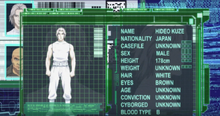
Kuze's physical traits, located by Ishikawa in Episode 13
His body, despite being outdated, is extremely robust and can regenerate skin, as noted by Ishikawa in Episode 13: FACE Make Up. It is equipped with invisible camouflage, just like Section 9's members. Even if the shell is difficult to use, Kuze is extremely adept with it due to him possessing it for many years. Furthermore, he knows every notch of its capacity and limits.
Kuze's PKF-issued body is physically stronger and more durable than the cyborg bodies of Section 9 operatives, even compared to the likes of Motoko and Batou. Kuze had been able to defeat Batou in hand-to-hand combat, while Motoko spoke of Kuze as "a reinforced cyborg" upon their first encounter. When Kuze attempted to assassinate Prime Minister Yoko Kayabuki, he was shot multiple times by both Major Kusanagi and Batou without sustaining severe damage. Although, this is most likely due to the fact that Kuze fights with his pain receptors turned off, contrasting other full-cyborgs like Motoko who prefers to have connections to the physical world at all times.
While in the Oshii Ghost in the Shell movies, both Major and Batou have been known to be basically bulletproof, the cyborg bodies in the Standalone Complex universe are much less durable. They can easily be damaged and even destroyed by bullets. Kuze's superior physical strength is thus considered in a completely different class compared to all other characters within the SAC universe.
Strengths[]
- Expert hand-to-hand combat : Since he was able to defeat Batou, a well-versed fighter, even with a damaged body, Kuze can be considered a top-class fighter.
- Skilled marksman
- Skilled swordsman : Hideo Kuze is able to defend himself with a sword against Motoko. He easily killed the Individual Eleven member who attacked him. Also he managed to disarm Batou during a gun versus knife fight.
- Augmented strength
- Superior speed
- Enhanced senses and intuition : Kuze is able to understand and assume the most critical situations with the slightest hints of information and data.
- Genius-level intellect : Gathering the minds of 3 million refugees and understanding them individually has made Kuze a highly intelligent individual with knowledge in numerous fields.
- Tactical awareness
- Indomitable determination : Kuze's extreme resilience has freed him from the Individual Eleven's control. Even at the face of failure, he is able to keep his composure and pursue his plans.
- Extreme durability and pain tolerance : Due to the build of his body and the deactivation of pain receptors, Kuze can significantly take bullets without issues. He also survived a Jigabachi assault, which exposed him to explosions and high falls.
- Skin regeneration : Kuze's skin was good as new after he reappeared following Motoko and Batou shooting him.
- Familiarity and knowledge of human and cyborg concepts
- Sleight of Hand : Kuze has practiced folding origami figures without the use of control software.
- Charisma and Management
- Hacking and systems programming
Weaknesses[]
- Nigh-obsolete paraphernalia : Kuze wears clothes and has no armor.
- Damaged Shell with heavily limited and reduced physical properties : Ever since he had his PKF body and left the army, Kuze never changed his body. However, he has come to master its remaining abilities.
- Infertility
- Lack of adequate weaponry : Aside from a few rifles and second-hand weapons, Kuze is not well equipped in terms of weapons and gadgets.
- Terminated social insurance and civil protection
- Gradual loss of humanity : Hideo Kuze's deteriorating body and rise as a legendary figure gradually turn him into an inhuman warmonger. His allies begin to lose faith in him.
- Public image sullied by media and news channels: Kuze is often treated as a terrorist by the media despite being set up by third-party sources most of the times like Gouda or refugees unaffiliated with his crew.
Relationships[]
Refugees of Dejima[]
The refugees of Dejima are an important community for Kuze. They have long suffered the same exclusion as he did, which is why he easily sympathises with them. He genuinely wants the best for their sake and tries to free them from the horrors of war. Cyborgs or human alike, races or ethnicity, Kuze doesn't judge anyone lesser than the other. The refugees look up to the rogue commando as a rallying figure, and those with true heart are willing to get to know him. Eventually, his extremist techniques create doubt, and his influence is somewhat damaged due to immense casualties. He nonetheless manages to keep them into one same organization thanks to his great aptitude for unification and his cybernet hub, with which he secretly uses to absorb and store their consciousness. Using the great strength of mass population, Kuze encourages the refugees to take more action in rationality rather than in pride, especially if they are to address an example of social inequity. Kuze has befriended two refugee fighters, who in turn, support him with passion.
In the end, Hideo's relationship with the refugees becomes strained as many of them prove to be selfish and egoist, and he is ultimately forced to carry this heavy burden along his path to save them. Still, Kuze doesn't falter at the face of an almost certain doom; as a last ditch effort, he sucessfully handles a rescue operation for the human refugees who were starting to lose trust in him. As for the rest, Kuze ends up creating a cyber-network based on his ghost, which fuses the refugees' souls with his own.
Motoko Kusanagi[]
Hideo Kuze and Major Motoko Kusanagi are primarily rivals during the Dejima Revolution, fighting against the other with steadfast resolve. Yet unbeknownst to everyone but themselves, they secretly share a story of long-lost childhood friendship and unconfessed love. Their relationship is heavily implied throughout 2nd GIG, even foreshadowed in some Season 1 episodes. Ever since his hospitalization, Kuze understood that his relatives didn't want anything to do with him. All alone, he came to view his fellow patient Motoko as the only person who would stay by his side. To find something to do, the young Kuze folded cranes to wish her well. Eventually, when the paralyzed Motoko had successfully recovered, she returned to see him. However, he didn't recognize her when she returned, as she was a cyborg and was too embarassed to tell him. Due to the bitterness of being abandoned by the world, he was not nice with her, and even chastised her for failing to build a paper crane for him. They continued to bury their emotions, and that would inevitably cause their separation. Motoko's abstinence in confessing Kuze the truth encouraged him to push her away, while he was too distracted to notice she liked him. Motoko ran off and Kuze finally realized his mistake. Though she promised to come back when she was able to return his expectations, Kuze waited to a point he thought she would never return; he became a cyborg and started looking for her. Motoko actually came back, but at the time she did, Kuze was already gone.
From that point, the two lived their adult lives on their own.
When fate finally brings them face to face once again, the two are standing on opposing sides. As enemies, they each have their own contrasting goals, with the fate of the future being their main driving factor. Motoko quickly gains interest in the cyborg fugitive when she's assigned to arrest him, and each time they have direct hostile encounters, a sense of familiarity inevitably grows. Eventually, she realizes that Kuze is indeed her childhood love. Despite being enemies, Motoko refuses to kill the very person who gave her a reason to live, and is convinced that she can do something to avoid being at odds with the threat he had become.
To save their strained relationship, Motoko eventually corners Kuze and urges him to relate to their former selves, making him wonder if their past can really shape the future. Ultimately, because of the Major's bias towards Kuze and vice-versa, they agree to work as one and end the ongoing conflict. This results in the refugees being safe, the foil of Gouda's plan and the reconciliation of their romance.
However, their reestablished bond doesn't last long as Kuze is soon murdered by the American Empire. Yet before he passes away, he says "I'll go on ahead". This may mean that he already went into cyberspace ahead of the others in order to start the cyber revolution. If so, it explains that after the conclusion of the last episode, the ghost of Kuze exists on the net as his perceived form. It has also been speculated that the Major's failure in saving his physical body may have sparked her departure from Public Safety Security Section 9. The Major has been away from her team for 2 years in Solid State Society, possibly trying to reconnect with him. Following the public explanation of director Kenji Kamiyama, Kuze's death was definitely the crucial reason for Motoko's departure.
Many hints and aspects about their relationship are seen throughout the series. Both characters are shown folding paper cranes with their left hand in several moments: the inception of their affection explained in episode 11, season 2. In episode 5, Kuze attaches a newly folded crane in his truck's reflector glass. Motoko is seen many times in the second season folding a crane subconsciously whenever she picks up papers or wrappings. During the Laughing Man incidents, when Motoko talks about her watch and Batou's training gear, she alludes that material love isn't important, implying that there is always a stronger bond from beyond. This is later revealed to be her affections for Kuze. Furthermore, when she is confronting a movie director in a standalone episode, Motoko states that dreams aren't meaningful if they keep repeating the past over and over. Her dream is possibly to find the first boy she loved, it is something that drives her forward.
The Individual Eleven Events also give hints and allusions about Kuze's true identity as the boy who folds cranes. Firstly, Gouda, the man who created the hoax, mentions that people can get infected by the virus if they were virgins before their cyber transformation. One should then consider that the boy was unable to have sex due to his age and his paralysis. Secondly, Kuze breaks off from the virus because his motivations were not in accord with the virus' ideology. In such case, the ultra-nationalist mentality must have dropped because of Kuze's driven goals and desire to find his friend, which had no correlation with the Individual Eleven ploy.
After diving into Kuze's cyberbrain, the Major becomes bothered by the suspicion that she knows him from somewhere. This "somewhere" is her childhood memories. In several moments of the Individual Eleven investigation, Motoko is troubled by her duties as a police officer and her feelings for Kuze.
Whether Kuze loved Motoko romantically is ambiguous. While Motoko admits her affections for him, Kuze's bond with the Major can be interpreted as friendship.
Batou[]
Batou and Kuze share an indirect rivalry. They're both the two men who Major can relate to. When Batou and Kuze first met, they were merely enemies. Kuze being one of Section 9's suspects, he was investigated by the Public Security. However, when the Major begins to show a strange behavior for Kuze, Batou is the first to notice. He starts having doubts and grudges against the white-haired fugitive, while witnessing Major's growing interest. Such feelings from Batou are further enhanced when Motoko, someone he trusts dearly, reveals that Kuze was her childhood love. On the other hand, Kuze does not see Batou as a liability, and in fact respects him, even pointing out genuine admiration after their fight. It could be possible that Kuze also knew of Batou's feelings for Motoko, since she had connected her ghost more than once with Kuze, giving him access to her very soul. When Batou had found Motoko and Kuze under the debris, he was temporarily stunned and surprised seeing the two enlacing each other, but quickly shrugged it off thanks to Kuze letting go of the Major instantly.
Yousuke Aramaki[]
Kuze and Yousuke Aramaki work together to help the refugees. Although the latter doesn't agree of Kuze's extremist ways, he still helps the young man in his quest for peace. He begs Kuze not to give up on the world and reminds him the importance of life.
Yoko Kayabuki[]
Kuze seems to despise Kayabuki for her lack of concern for the refugees. He attacks her relentlessly, but leaves her alive. He knows that despite their differences, an opportunity for a second chance is always open. In the end of the 2nd GIG, it is revealed he harbors no hatred, but merely frustration.
Antique Shop owner[]
The Antique Shop owner was someone Kuze was familiar with, to various degrees. He had found shelter under her shop during his young adult years, giving her his memories and experiences while in University. In contrast to most her clients, Kuze did not give his memories to forget, but to remember. They kept close contact until the cyborg was deployed by order of the UN troops. When he had disappeared, the Antique Shop owner took on his stead to tend to his old body, stored in a model car alongside his childhood lover's.
The Laughing Man[]
Hideo Kuze has met Aoi during his time at the Leigo Island Incident. Initially distrusful of The Laughing Man, Kuze grows to respect the latter. Aoi gave Kuze his pseudonym before they parted ways.
Quotes[]
"Can you fold origami cranes with your prosthetic hand? If you can, then I guess I wouldn't mind getting a prosthetic body too" - The Antique Shop owner citing the young Kuze's fateful request
"...The man's prosthetic hair had gone white, but even so, it was positive that it was Kuze. The proof was obvious. Wherever "Kuze" went, a crowd of happy people always gathered around him" - Ishikawa's report about Kuze, Season 2 Episode 16
"Just as water runs downhill, the human heart also tends to revert to its basest instincts" - Kuze to Yousuke, addressing the difficulties of his revolution, Season 2 Episode 23
"Since then, I've come to value their goals, I have dedicated myself into helping them fulfill their dream and made that my sole motivating principle. That's why it wasn't difficult to become leader of these people" - Kuze announcing his resolve to Yousuke, Season 2 Episode 23
"When people feel no sense of responsibility, no matter what intended consequences of their actions, they make poor use of the Net" -Kuze reveals to Motoko the reason of his anger against the media and the political leaders, Season 2 Episode 25
"It sounds like you've endured your fair share of loneliness too. I never asked: What's your name?" -Kuze realizes Motoko is the girl he had spent his life searching for, Season 2 Episode 26
"...I'll go on ahead" -Kuze speaks to Motoko's ghost as he succumbs to the infectious micromachines, Season 2 Episode 26
Etymology[]
Hideo Kuze's name is written in katakana, not actually in kanji, to emphasize the fact it is a pseudonym : a name without a clear meaning.
- The name Hideo is written in katakana (ヒデオ), which has no special meaning. However, when written in kanji (秀男, 秀夫, 秀雄, 英夫, 英朗, 英郎, 豪雄, 栄夫 or 日出夫), it could possibly mean:
- 秀男 - "excellent, outstanding" (秀) (hide) and "male, man" (男) (o).
- 秀夫 - "excellent, outstanding" (秀) (hide) and "man, husband" (夫) (o).
- 秀雄 - "excellent, outstanding" (秀) (hide) and "hero, manly" (雄) (o).
- 英夫 - "excellent, fine" (英) (hide) and "man, husband" (夫) (o).
- 英朗 - "excellent, fine" (英) (hide) and "melodious, clear, bright, serene, cheerful" (朗) (o).
- 英郎 - "excellent, fine" (英) (hide) and "son" (郎) (o).
- 豪雄 - "overpowering, great, powerful, excelling, Australia, fine feathers, writing brush, little" (豪) (hide) and "hero, manly" (雄) (o).
- 栄夫 - "flourish, prosperity, honor, glory, splendor" (栄) (hide) and "man, husband" (夫) (o).
- 日出夫 - "sunrise" (日出) (hide) and "man, husband" (夫) (o).
Trivia[]
- His likeness is based on Japanese-Taiwanese actor Takeshi Kaneshiro.
- Hideo Kuze's beliefs about subconsciousness, individualism, and empiricism allude to thinkers such as Sigmund Freud, Carl Jung and John Locke.
- Wanting to bring the Puppet Master in an ideal situation for the SAC continuity, Director Kenji Kamiyama and Mamoru Oshii decided to adapt Kuze to have more of a social impact and an intimate relationship with the Major.
- Rikiya Koyama, Kuze's Japanese VA, has voiced many characters in anime, including Yamato from the Naruto series. Koyama shares a good working friendship with Motoko's voice actress Atsuko Tanaka. She appears with him in Naruto as well, in which her role is the character of Konan.
- Kirk Thornton, Kuze's English VA, is mostly known to be the voice of Hajime Saitou from Rurouni Kenshin.
- Koyama and Thornton have shared the role of the same anime character twice: Hideo Kuze and Kiritsugu Emiya from the Fate series.
- Kuze is similar to Roy Batty from the movie Blade Runner. They are both ex-soldiers, durable combat units, and possess a great strategic mind. They also serve as the "philosopher" character in their universe, and have white hair.
2017 film[]
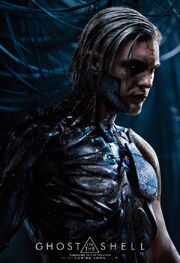
Live-action Kuze
Main article: Hideo Kuze (2017)
In the live-action adaptation, Kuze is played by actor Michael Pitt. The characterization in that movie also contains elements of both the Laughing Man and the Oshii version of the Puppet Master. He is at first introduced as a mysterious terrorist who is killing prominent scientists, mostly by hacking into their cyberbrains. Once he captures Major, he reveals his plan to spread his ghost online, while also revealing that his cyborg nature is due to being part of the same project that eventually created her. Major eventually discovers Kuze was Hideo, one of the brothers in arms of her original identity Motoko Kusanagi in a rebellion against Hanka Robotics, who after suffering an identity wipe through Project 2571 became unbalanced and murderous. He later finds the Major in their old home, but is ambushed by the Hanka Spider Tank, which is destroyed by the Major. However, both are damaged after the fight and Kuze is shot by a sniper. However, this Kuze has no link whatsoever with cranes, and does not unite people into an objective point. In contrast of the original Kuze, this version of the character has more emphasis on personal vengeance.
See also[]
- Motoko Kusanagi
- Puppet Master
- The Laughing Man
- Kazundo Gouda
- Dejima Island
- World War IV
- Ghost in the Shell: Stand Alone Complex 2nd GIG
- The Ghost in the Shell: Five New Short Stories
References[]
- ↑ In Episode 12, viewers can see Kuze's mouth move for a short time when he was speaking to other Individual Eleven members. Also, a Section 9 forensic expert in Episode 13 comments that while his mouth remains motionless, Hideo has great difficulty in moving it.
- ↑ The surname of Hideo Kuze's family was revealed in the short story Soft and White by Kafka Asagiri as it appeared in the prose anthology The Ghost in the Shell: Five New Short Stories.
- ↑ This was confirmed in the short story Soft and White.
- ↑ Episode 12, season 2 - Kusanagi's Labyrinth: AFFECTION
- ↑ Mentioned by Ishikawa in 2nd GIG, Episode 16 during his debriefing session with Batou and the others via cyberbrain diving kit
- ↑ This information led Motoko to head to Taiwan and conduct her investigation there, as seen in 2nd GIG' episode 17.
- ↑ Episode 16, season 2 : The Fact of Being There - ANOTHER CHANCE
- ↑ The events summarized under this paragraph and the rest of the sub-heading are chronicled in the short prose story Soft and White by Kafka Asagiri, as it appeared in the collection The Ghost in the Shell: Five New Short Stories.
- ↑ Episode 5, season 2 : Those With The Motive
- ↑ Episode 13, season 2
- ↑ He believed that this is a revolution that will lead humanity to a higher structure. This concept is somewhat similar to what was stated by Project 2501, better known as the Puppetmaster, in the GITS movies and manga.
| Characters of Ghost in the Shell |
| Public Security Section 9 Motoko Kusanagi |
Daisuke Aramaki |
Batou |
Togusa |
Ishikawa |
Saito |
Pazu |
Boma | |
| Japanese Government and Military Kubota |
Kaoru Yakushima(S.A.C.) |
Prime Minister(S.A.C.) |
Yoko Kayabuki(2nd GIG) | |
| Other Affiliations Puppet Master |
Laughing Man(S.A.C.) |
Hideo Kuze |
Kurutsu(Arise) |
Akira Hose(Arise) | |


